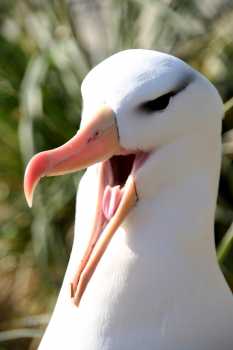Paulo Catry (Eco-Ethology Research Unit, ISPA, Lisbon, Portugal) and colleagues have published on-line in the journal Polar Biology on moult of the ACAP-listed Black-browed Albatross Thalassarche melanophris.
The paper’s abstract follows:
“Moult entails costs related to the acquisition of energy and nutrients necessary for feather synthesis, as well as the impact of reduced flight performance induced by gaps in the wing plumage. Variation in moult strategies within and between populations may convey valuable information on energetic trade-offs and other responses to differing environmental constraints. We studied the moult strategies of two populations of a pelagic seabird, the black-browed albatross Thalassarche melanophris, nesting in contrasting environments. According to conventional wisdom, it is exceptional for albatrosses (Diomedeidae) to moult while breeding. Here we show that black-browed albatrosses breeding on the Falklands regularly moult primaries, tail and body feathers during chick-rearing, and the majority of those at South Georgia show some body feather moult in late chick-rearing. The greater moult-breeding overlap at the Falklands allows the birds to annually renew more primary feathers than their counterparts at South Georgia. The results of the present paper, pooled with other evidence, suggest that black-browed albatrosses from South Georgia face a more challenging environment during reproduction. They also serve to warn against the uncritical acceptance of conventional ideas about moult patterns when using feathers to study the ecology of seabirds and other migrants for which there is scant information at particular stages of the annual cycle.”

Black-browed Albatross. Photograph by Oli Yates
Reference:
Catry, P., Poisbleau, M., Lecoq, M. & Phillips, R.A. 2013. Differences in the timing and extent of annual moult of black-browed albatrosses Thalassarche melanophris living in contrasting environments. Polar Biology DOI 10-1007/s00300-013-1309-5.
John Cooper, ACAP Information Officer, 12 March 2013

 English
English  Français
Français  Español
Español